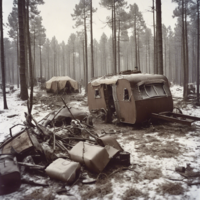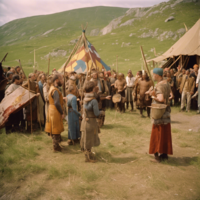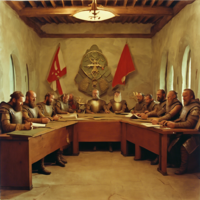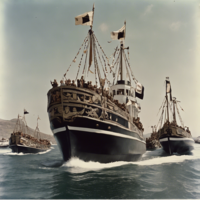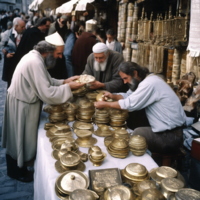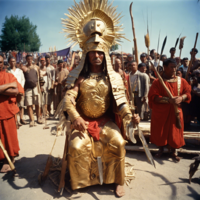New South Jangsong Campaign: Difference between revisions
NewZimiaGov (talk | contribs) |
NewZimiaGov (talk | contribs) |
||
| (13 intermediate revisions by the same user not shown) | |||
| Line 50: | Line 50: | ||
===Economic Factors=== | ===Economic Factors=== | ||
[[File:8e32102d-80f2-4b73-b96d-249768ea074d.png|200px|thumb|right|One of the major catalysts for Bassarid military intervention in New South Jangsong was the growing frequency of Normarkian attacks against Bassarid trade caravans passing through the region.]] | |||
Economically, the region of New South Jangsong is significant due to its rich resources, strategic ports, and vibrant trade networks. The local economy thrives on a mix of maritime commerce, artisanal crafts, and agriculture, particularly vineyards and orchards. Bassaridia Vaeringheim's interest in the region was largely driven by the desire to control these lucrative trade routes and resources. Economic disruptions, such as blockades and sabotage by the Hatch Ministry, aimed to weaken local economies and force integration into the Bassarid trade system. The region's economic resilience and local trade networks posed significant challenges to Bassarid dominance. | Economically, the region of New South Jangsong is significant due to its rich resources, strategic ports, and vibrant trade networks. The local economy thrives on a mix of maritime commerce, artisanal crafts, and agriculture, particularly vineyards and orchards. Bassaridia Vaeringheim's interest in the region was largely driven by the desire to control these lucrative trade routes and resources. Economic disruptions, such as blockades and sabotage by the Hatch Ministry, aimed to weaken local economies and force integration into the Bassarid trade system. The region's economic resilience and local trade networks posed significant challenges to Bassarid dominance. | ||
| Line 139: | Line 140: | ||
In this uneasy atmosphere, the Bassaridians faced the daunting task of consolidating their control while navigating the delicate balance between asserting authority and appeasing a populace still scarred by the memory of conflict. The road to stability would be fraught with challenges, as they sought to win over hearts and minds in a region where the legacy of war cast a long shadow over the prospects of lasting peace. | In this uneasy atmosphere, the Bassaridians faced the daunting task of consolidating their control while navigating the delicate balance between asserting authority and appeasing a populace still scarred by the memory of conflict. The road to stability would be fraught with challenges, as they sought to win over hearts and minds in a region where the legacy of war cast a long shadow over the prospects of lasting peace. | ||
===Continuation of Conflict=== | |||
====Salt-Lindley Campaign==== | |||
{{infobox military conflict | |||
| conflict = Salt-Lindley Campaign | |||
| partof = New South Jangsong Campaign | |||
| image = [[File:Village3.png|200px|thumb|center|Villages such as this one, constructed atop the rocky outcrops scattered around Pelagia's salt flats, were a focal point for fighting during the Salt-Lindley Campaign.]] | |||
| caption = | |||
| date = 50.73 PSSC | |||
| place = [[Pelagia]]’s salt flats and surrounding “island” villages | |||
| coordinates = | |||
| map_type = | |||
| latitude = | |||
| longitude = | |||
| map_size = | |||
| map_caption = | |||
| map_label = | |||
| territory = No permanent territorial changes; trade routes secured | |||
| result = Costly but decisive victory for the [[New South Jangsong Division]] | |||
| status = Concluded | |||
| combatant1 = {{flagicon image|Imperial Trade Union flag.png|200px}} [[New South Jangsong Division]] | |||
| combatant2 = {{flagicon image|Jangsong flag.png|200px}} Jangsong Insurgents | |||
| commander1 = {{flagicon image|Imperial Trade Union flag.png|200px}} Field Marshal Daryush Bey | |||
| commander2 = {{flagicon image|Jangsong flag.png|200px}} Various insurgent leaders | |||
| units1 = | |||
'''Ground Units:'''<br> | |||
~3,000 active troops<br> | |||
~1,500 reservists<br> | |||
13 [https://micras.org/mwiki/Somniant_Stock_Fund_Military_Hardware#Makra_Class_Battle_Tank Makra Class Battle Tank]<br> | |||
8 [https://micras.org/mwiki/Somniant_Stock_Fund_Military_Hardware#Laya_Class_Heavy_Tank Laya Class Heavy Tank]<br> | |||
20 [https://micras.org/mwiki/Somniant_Stock_Fund_Military_Hardware#Arachne_Class_Light_Tank Arachne Class Light Tank]<br> | |||
10 [https://micras.org/mwiki/Somniant_Stock_Fund_Military_Hardware#Thalassa_Class_Main_Battle_Tank Thalassa Class Main Battle Tank]<br> | |||
5 [https://micras.org/mwiki/Somniant_Stock_Fund_Military_Hardware#Onceanic_Recon_Vehicle Onceanic Recon Vehicle]<br> | |||
4 [https://micras.org/mwiki/Somniant_Stock_Fund_Military_Hardware#Ephyra_Class_Anti-Aircraft_Vehicle Ephyra Class Anti-Aircraft Vehicle]<br> | |||
6 [https://micras.org/mwiki/Somniant_Stock_Fund_Military_Hardware#Aithra_Class_Howitzer Aithra Class Howitzer]<br> | |||
8 [https://micras.org/mwiki/Somniant_Stock_Fund_Military_Hardware#155mm_Halicarn_Class_Self-Propelled_Howitzer 155mm Halicarn Class Self-Propelled Howitzer]<br> | |||
'''Air Units:'''<br> | |||
12 [https://micras.org/mwiki/Somniant_Stock_Fund_Military_Hardware#Symphonara_Class_Compound_Intercept Symphonara Class Compound Intercept]<br> | |||
6 [https://micras.org/mwiki/Somniant_Stock_Fund_Military_Hardware#Chrysos_Class_Sea_Bomber Chrysos Class Sea Bomber]<br> | |||
3 [https://micras.org/mwiki/Somniant_Stock_Fund_Military_Hardware#Misttalon_Class_Heavy_Bomber Misttalon Class Heavy Bomber]<br> | |||
10 [https://micras.org/mwiki/Somniant_Stock_Fund_Military_Hardware#Catonis_Class_Unmanned_Aircraft Catonis Class Unmanned Aircraft]<br> | |||
| units2 = | |||
Jangsong Insurgents<br> | |||
~1,000 mechanized and infantry fighters<br> | |||
Improvised armor, IEDs, mortar pits, and fortified bunkers | |||
| strength1 = | |||
'''Ground + Air:''' ~4,500 total personnel | |||
| strength2 = | |||
~1,000 insurgents (mechanized + infantry) | |||
| casualties1 = | |||
320 killed, 780 wounded | |||
| casualties2 = | |||
600 killed, 400 wounded or captured | |||
| notes = | |||
Following a series of raids against salt caravans, the [[New South Jangsong Division]] initiated the Salt-Lindley Campaign to protect [[Pelagia]]’s economic lifeline. Intense fighting at [[Lindley Pass]] and protracted sieges of local “island” communities resulted in high casualty rates on both sides. Despite the losses, the campaign successfully shattered the insurgency’s chain of command and restored Pelagia’s trade network. | |||
}} | |||
The Salt-Lindley Campaign was a protracted and high-casualty operation conducted solely by the [https://micras.org/mwiki/Bassaridia_Vaeringheim#Bassaridian_War_League New South Jangsong Division] of the [https://micras.org/mwiki/Bassaridia_Vaeringheim#Bassaridian_War_League Bassaridian War League] in 50.73 PSSC. The campaign unfolded in several distinct phases, spanning reconnaissance operations, a decisive armored thrust at Lindley Pass, intensive aerial bombardments of coastal strongholds, and sustained siege warfare in [https://micras.org/mwiki/List_of_cities_in_Bassaridia_Vaeringheim#Pelagia Pelagia]’s remote “island” communities. These extensive efforts, while costly in manpower, effectively halted the Jangsong Insurgents’ grip on the salt flats and reasserted Bassaridian control over critical trade corridors. | |||
=====Background===== | |||
Throughout 50.72 PSSC, [https://micras.org/mwiki/List_of_cities_in_Bassaridia_Vaeringheim#Pelagia Pelagia]’s trade caravans reported escalating ambushes perpetrated by well-armed groups alleging loyalty to the Jangsong Insurgents. This loose coalition comprised disaffected Normarkian mercenaries, former local militias, and opportunistic brigands who capitalized on the region’s harsh conditions. Official city council records described the rapid transformation of opportunistic highway thefts into coordinated strikes, marked by improvised armor, concealed bunkers, and sabotage teams adept at exploiting desert mirages and swirling dust devils. Fearing the collapse of its salt-dependent economy, Pelagia appealed to the [https://micras.org/mwiki/Bassaridia_Vaeringheim#Bassaridian_War_League Bassaridian War League] for urgent assistance. In response, the War League designated the [https://micras.org/mwiki/Bassaridia_Vaeringheim#Bassaridian_War_League New South Jangsong Division], led by Field Marshal Daryush Bey, as the sole military force to restore order. | |||
From 50.72 to early 50.73 PSSC, the situation deteriorated as the Jangsong Insurgents utilized improvised explosive devices (IEDs) and mortars to degrade local defenses, compelling entire settlements to pay tribute. Several smaller “island” villages—patches of higher ground emerging from the salt flats—were either abandoned or forcibly drafted into supporting the insurgents’ war machine. Intelligence indicated that, without direct intervention, these disruptions would sever [https://micras.org/mwiki/List_of_cities_in_Bassaridia_Vaeringheim#Pelagia Pelagia]’s commerce and possibly spread instability into neighboring Haifan territories. | |||
=====Forces and Composition===== | |||
Field Marshal Bey commanded a total of 4,500 personnel, divided into front-line mechanized infantry, artillery regiments, armor contingents, and an organic air wing. Approximately 3,000 served actively in infantry and support roles, while 1,500 reservists were responsible for logistics, engineering, and medical operations. Heavy armor included 13 [https://micras.org/mwiki/Somniant_Stock_Fund_Military_Hardware#Makra_Class_Battle_Tank Makra Class Battle Tanks] and 8 [https://micras.org/mwiki/Somniant_Stock_Fund_Military_Hardware#Laya_Class_Heavy_Tank Laya Class Heavy Tanks] for spearheading assaults, supplemented by 20 [https://micras.org/mwiki/Somniant_Stock_Fund_Military_Hardware#Arachne_Class_Light_Tank Arachne Class Light Tanks] and 10 [https://micras.org/mwiki/Somniant_Stock_Fund_Military_Hardware#Thalassa_Class_Main_Battle_Tank Thalassa Class Main Battle Tanks] offering rapid maneuverability and flanking capacity. Reconnaissance units fielded 5 [https://micras.org/mwiki/Somniant_Stock_Fund_Military_Hardware#Onceanic_Recon_Vehicle Onceanic Recon Vehicles] for early warning, and 4 [https://micras.org/mwiki/Somniant_Stock_Fund_Military_Hardware#Ephyra_Class_Anti-Aircraft_Vehicle Ephyra Class Anti-Aircraft Vehicles] shielded ground columns from potential aerial or drone threats. | |||
Artillery support featured 6 [https://micras.org/mwiki/Somniant_Stock_Fund_Military_Hardware#Aithra_Class_Howitzer Aithra Class Howitzers] for indirect fire missions and 8 [https://micras.org/mwiki/Somniant_Stock_Fund_Military_Hardware#155mm_Halicarn_Class_Self-Propelled_Howitzer 155mm Halicarn Class Self-Propelled Howitzers] for long-range mobile bombardment. The Division’s autonomous air wing relied on 12 [https://micras.org/mwiki/Somniant_Stock_Fund_Military_Hardware#Symphonara_Class_Compound_Intercept Symphonara Class Compound Intercept fighters] to establish air superiority and provide close air support. Six [https://micras.org/mwiki/Somniant_Stock_Fund_Military_Hardware#Chrysos_Class_Sea_Bomber Chrysos Class Sea Bombers] delivered precision strikes on enemy positions, while 3 [https://micras.org/mwiki/Somniant_Stock_Fund_Military_Hardware#Misttalon_Class_Heavy_Bomber Misttalon Class Heavy Bombers] handled large-scale bombardments against heavily fortified targets. Overhead surveillance and target acquisition were maintained by 10 [https://micras.org/mwiki/Somniant_Stock_Fund_Military_Hardware#Catonis_Class_Unmanned_Aircraft Catonis Class Unmanned Aircraft], which operated continuously across the salt flats and coastal regions. | |||
=====Preliminary Reconnaissance and Early Clashes===== | |||
Before commencing full-scale assaults, the [https://micras.org/mwiki/Bassaridia_Vaeringheim#Bassaridian_War_League New South Jangsong Division] initiated a period of reconnaissance to locate insurgent concentrations and trace concealed supply lines. [https://micras.org/mwiki/Somniant_Stock_Fund_Military_Hardware#Catonis_Class_Unmanned_Aircraft Catonis Class Unmanned Aircraft] frequently detected clusters of vehicles hidden by camouflage netting and large nighttime fires indicative of arms reconditioning. Probing actions by [https://micras.org/mwiki/Somniant_Stock_Fund_Military_Hardware#Arachne_Class_Light_Tank Arachne Class Light Tanks] confirmed the presence of extensive trench systems near Lindley Pass, as well as sophisticated roadside bombs triggered by pressure plates buried under the salt surface. | |||
Clashes intensified around 50.75 PSSC, when an intelligence-gathering patrol along the inland trade route was ambushed by makeshift rocket launchers. Several infantry squads became pinned down until a barrage from two [https://micras.org/mwiki/Somniant_Stock_Fund_Military_Hardware#Aithra_Class_Howitzer Aithra Class Howitzers] neutralized the attackers. These early engagements resulted in around 40 Bassarid deaths and more than 90 wounded, highlighting the Jangsong Insurgents’ capacity for coordinated ambushes. Concurrently, efforts to evacuate civilians from at-risk island villages were hampered by insurgent sniper teams who took advantage of elevated terrain, inflicting further losses on convoys ferrying supplies and wounded personnel. | |||
=====Lindley Pass Offensive===== | |||
The primary offensive, termed the Lindley Pass Offensive, began just before daybreak on 50.76 PSSC. Reconnaissance from [https://micras.org/mwiki/Somniant_Stock_Fund_Military_Hardware#Catonis_Class_Unmanned_Aircraft Catonis Class Unmanned Aircraft] showed extensive insurgent berms, trenches, and mortar pits around the pass. To dislodge these defenses, the Division launched four [https://micras.org/mwiki/Somniant_Stock_Fund_Military_Hardware#Symphonara_Class_Compound_Intercept Symphonara Class Compound Intercept fighters] on a low-flying sweep, strafing picket lines and forcing enemy combatants to retreat underground. Minutes later, three [https://micras.org/mwiki/Somniant_Stock_Fund_Military_Hardware#Misttalon_Class_Heavy_Bomber Misttalon Class Heavy Bombers] released high-explosive payloads on the trench system, incinerating stockpiles of ammunition and collapsing multiple bunkers. | |||
Seizing the momentum, the 4th Armored Regiment advanced in two parallel columns. One column included [https://micras.org/mwiki/Somniant_Stock_Fund_Military_Hardware#Makra_Class_Battle_Tank Makra Class Battle Tanks] and [https://micras.org/mwiki/Somniant_Stock_Fund_Military_Hardware#Laya_Class_Heavy_Tank Laya Class Heavy Tanks], delivering sustained cannon fire to suppress entrenched positions. The second column, composed of [https://micras.org/mwiki/Somniant_Stock_Fund_Military_Hardware#Arachne_Class_Light_Tank Arachne Class Light Tanks] and [https://micras.org/mwiki/Somniant_Stock_Fund_Military_Hardware#Thalassa_Class_Main_Battle_Tank Thalassa Class Main Battle Tanks], executed rapid flanking maneuvers along alternate routes. Artillery support from [https://micras.org/mwiki/Somniant_Stock_Fund_Military_Hardware#155mm_Halicarn_Class_Self-Propelled_Howitzer 155mm Halicarn Class Self-Propelled Howitzers] pounded rear fortifications, preventing an organized retreat. The fighting was fiercest at a narrow salt ridge, where insurgents utilized heavy machine guns and rocket-propelled grenades to disable two [https://micras.org/mwiki/Somniant_Stock_Fund_Military_Hardware#Makra_Class_Battle_Tank Makra Class Battle Tanks], resulting in five crew fatalities and numerous severe injuries. By midday, infantry squads deploying from [https://micras.org/mwiki/Somniant_Stock_Fund_Military_Hardware#Syrinx_Class_Armored_Infantry_Vehicle Syrinx Class Armored Infantry Vehicle] carriers had overrun the main trench lines, capturing or killing several hundred insurgents, including an entire rearguard formation that was annihilated by concentrated artillery and tank fire. | |||
=====Bombing of Coastal Strongholds===== | |||
With Lindley Pass secured, Division intelligence indicated that a large segment of the Jangsong Insurgents had withdrawn to coastal settlements situated north of [https://micras.org/mwiki/List_of_cities_in_Bassaridia_Vaeringheim#Pelagia Pelagia]. Field Marshal Bey ordered six [https://micras.org/mwiki/Somniant_Stock_Fund_Military_Hardware#Chrysos_Class_Sea_Bomber Chrysos Class Sea Bombers] to conduct sustained aerial assaults on these harbor enclaves, based on confirmed target coordinates from [https://micras.org/mwiki/Somniant_Stock_Fund_Military_Hardware#Catonis_Class_Unmanned_Aircraft Catonis Class Unmanned Aircraft]. High-yield ordnance and thermobaric munitions collapsed bunkers, smoldered vehicle depots, and neutralized improvised anti-air platforms. As insurgents attempted to retreat inland, overhead [https://micras.org/mwiki/Somniant_Stock_Fund_Military_Hardware#Symphonara_Class_Compound_Intercept Symphonara Class Compound Intercept fighters] strafed fleeing convoys, further weakening the insurgency’s capacity for regrouping. However, the counterattacks were fierce: bombing teams encountered retaliatory shelling and nighttime raids on forward airstrips, resulting in around 200 Bassarid fatalities during these coastal operations. The Jangsong forces, for their part, sustained devastating casualties; intelligence suggested that numerous high-ranking leaders were killed or gravely wounded, triggering irreparable fractures in their chain of command. | |||
=====Siege of the “Island” Villages===== | |||
Concurrently, the Division launched siege operations in the remote “island” villages scattered across the salt flats. These elevated enclaves had become reluctant safe havens for insurgent groups that coerced local inhabitants into providing shelter and resources. Bassarid infantry units established cordons around each village, with [https://micras.org/mwiki/Somniant_Stock_Fund_Military_Hardware#Ephyra_Class_Anti-Aircraft_Vehicle Ephyra Class Anti-Aircraft Vehicles] stationed to prevent possible drone assaults. The sieges typically started with [https://micras.org/mwiki/Somniant_Stock_Fund_Military_Hardware#Catonis_Class_Unmanned_Aircraft Catonis Class Unmanned Aircraft] spotting insurgent gun emplacements and mortar pits. [https://micras.org/mwiki/Somniant_Stock_Fund_Military_Hardware#Aithra_Class_Howitzer Aithra Class Howitzers] then delivered smoke or warning rounds to suppress movement, followed by advances of light armor—often [https://micras.org/mwiki/Somniant_Stock_Fund_Military_Hardware#Arachne_Class_Light_Tank Arachne Class Light Tanks]—that helped isolate fleeing combatants. | |||
Fighting in the tight confines of these hamlets proved lethal. Insurgent marksmen exploited rooftops and improvised scaffolding, while mortar crews rained shells from concealed dune positions. Casualty rates soared on both sides during these village operations: estimates indicated over 80 additional Bassarid soldiers killed and nearly 200 severely wounded. Yet, each secured settlement revealed caches of stolen supplies, black-market weaponry, and forcibly recruited labor. By the end of the two-week siege sequence, the insurgents’ logistical backbone had been destroyed in the villages, further crippling their ability to reorganize. | |||
=====Casualties and Aftermath===== | |||
By late 50.78 PSSC, the [https://micras.org/mwiki/Bassaridia_Vaeringheim#Bassaridian_War_League New South Jangsong Division] declared the Salt-Lindley Campaign concluded but at a high cost. Official tallies indicated approximately 320 Bassarid troops killed and 780 wounded, reflecting the intensity of trench assaults, coastal raids, and village sieges. Among the Jangsong Insurgents, an estimated 600 were killed in direct engagements or bombing sorties, and around 400 more were wounded or captured. The collapse of their command structure forced remaining cells to dissolve or retreat into uninhabited desert regions, leaving behind destroyed bunkers, burning vehicle husks, and traumatized civilian populations. | |||
Criticism arose within [https://micras.org/mwiki/List_of_cities_in_Bassaridia_Vaeringheim#Pelagia Pelagia] over the extensive bombings that ravaged coastal settlements and the collateral damage to several “island” villages, yet the city council defended the campaign as a dire necessity to protect commerce and avert a full-blown insurgent occupation. With Lindley Pass and the coastal routes secured, caravans swiftly resumed the transport of salt and other vital resources, stabilizing Pelagia’s economy. Engineers repaired roads, rebuilt damaged rest stations, and provided limited compensation to villagers who had lost homes or property. | |||
Despite lingering resentment in some communities, military analysts widely acknowledged Field Marshal Bey’s integrated warfare strategy—merging armor columns, concentrated artillery, and dedicated air support—as the decisive factor in shattering the insurgency. The Salt-Lindley Campaign stands as one of the [https://micras.org/mwiki/Bassaridia_Vaeringheim#Bassaridian_War_League New South Jangsong Division]’s most complex and destructive endeavors, simultaneously preventing broader regional destabilization and securing Bassaridian strategic interests in the Northern Strait region. | |||
[[Category:Conflicts]] | [[Category:Conflicts]] | ||
[[Category:Bassaridia Vaeringheim]] | [[Category:Bassaridia Vaeringheim]] | ||
[[Category:Bassarid Periphery]] | [[Category:Bassarid Periphery]] | ||
Latest revision as of 20:30, 14 January 2025
The New South Jangsong Campaign was a conflict between the Bassaridian War League and the independent city-states of New South Jangsong. It was a multifaceted struggle rooted in the strategic significance of the Northern Strait of Haifa. As Bassaridia Vaeringheim sought to expand its control over this vital maritime trade route, the independent cities, with their unique blend of Bassarid, Haifan, and Normarkian heritage, resisted external dominance. This clash of interests led to a series of covert operations, military incursions, and diplomatic maneuvers by the Hatch Ministry aimed at disrupting local power structures and integrating the region into the Bassarid sphere of influence. Compounding the tension were economic factors, as the region's rich resources and thriving trade networks attracted Bassarid ambitions, and cultural dynamics, with Reformed Stripping Path missionaries attempting to convert the population, adding layers of religious and social complexity to the ongoing conflict.
| New South Jangsong Campaign | |||||||
|---|---|---|---|---|---|---|---|
|
|||||||
| Belligerents | |||||||
| Commanders and leaders | |||||||
| Strength | |||||||
Background
Historical Context
The conflict between the Hatch Ministry and the cities of New South Jangsong stemmed from the strategic importance of the Northern Strait of Haifa. This waterway is crucial for maritime trade routes that benefit the Dionysian trade empire of Bassaridia Vaeringheim. The region's cities, with their semi-independent status and mixed cultural influences, have historically resisted external control. The Hatch Ministry, with the support of a portion of the Vaeringheim Division and Reformed Bassarid Missionaries, was tasked with securing these trade routes and establishing Bassarid political dominance, leading to a series of covert and overt operations aimed at undermining local resistance and integrating the region into the Bassarid sphere of influence.
Cultural and Ethnic Dynamics
The region of New South Jangsong is a melting pot of cultures, blending elements of Bassarid, Haifan, and Normarkian cultures. This unique cultural synthesis has fostered a strong local identity resistant to outside influence. The cities maintain distinct traditions, social structures, and governance styles that reflect their dual heritage. The cultural pride and diverse ethnic composition of the region complicate efforts by external powers, such as the Bassarids, to impose uniform control. These dynamics fuel local resistance and complicate the War League's mission to integrate the region under Bassarid hegemony.
Geopolitical Tensions
Geopolitical tensions in the region were driven by the strategic importance of controlling the Northern Strait of Haifa. The Bassarid Empire, seeking to expand its influence and secure vital trade routes, viewed the semi-autonomous cities of New South Jangsong as both an opportunity and a threat. The local city-states, valuing their independence, were wary of Bassarid encroachment, and in certain cases, actively opposed the growth of Bassarid trade routes through the region. This led to a complex interplay of alliances, espionage, and military maneuvers as both sides vied for control. The involvement of other independent regional powers, either supporting the local cities or seeking their own gains, further exacerbated the tensions.
Economic Factors
Economically, the region of New South Jangsong is significant due to its rich resources, strategic ports, and vibrant trade networks. The local economy thrives on a mix of maritime commerce, artisanal crafts, and agriculture, particularly vineyards and orchards. Bassaridia Vaeringheim's interest in the region was largely driven by the desire to control these lucrative trade routes and resources. Economic disruptions, such as blockades and sabotage by the Hatch Ministry, aimed to weaken local economies and force integration into the Bassarid trade system. The region's economic resilience and local trade networks posed significant challenges to Bassarid dominance.
Religious Influence
The operations of Reformed Stripping Path missionaries added another layer of complexity to the conflict. These missionaries sought to convert the population of New South Jangsong to their faith, promoting a syncretic religion that combined elements of local beliefs with Bassarid spiritual practices. Their efforts were met with varying degrees of resistance and acceptance. While some locals saw conversion as a means to gain favor with the powerful Bassarids, others viewed it as an erosion of their cultural identity. The missionaries' influence aligned with Bassarid political interests, furthering the War League's goals by softening local resistance and fostering a sense of shared identity with the empire.
Operation Details
Hatch Ministry and Alpazkigz Campaign
In 49.19 PSSC, a portion of Hatch Ministry forces were deployed to New South Jangsong on a mission to investigate reports of disruption to Bassarid trade networks in the region. In 49.49, this mission was expanded, with minimal support from the Alpazkigz Division, to include active combat operations against insurgent forces in the region which sought to eliminate Bassarid economic influence in New South Jangsong. The purpose of these combat operations was to weaken opposition to Bassarid political and economic influence prior to the arrival of Reformed Bassarid missionaries and the Vaeringheim Division.
Bjornopolis
In Bjornopolis, an inland city known for its bustling agora, where Normarkian traders and Haifan merchants exchanged goods, the Hatch Ministry executed a covert operation designed to infiltrate key merchant guilds. The Hatch Ministry's covert operation in Bjornopolis encountered significant resistance as they sought to infiltrate the city's influential merchant guilds. These guilds, deeply entrenched in the city's economic fabric, proved to be a formidable obstacle to Bassarid intrusion. Suspicion ran rampant among guild members, leading to a wave of paranoia that hindered the Ministry's efforts to plant their agents. Despite facing staunch opposition, the Bassarid operatives persisted, employing a combination of stealth and persuasion to navigate the intricate web of guild politics. Over time, they managed to sow seeds of discord among the guild leadership, exploiting rivalries and personal vendettas to weaken resistance from within. Through strategic alliances and carefully orchestrated maneuvers, the Ministry gradually gained influence over key guilds, paving the way for increased Bassarid control over Bjornopolis' economic power structures.
Aegirheim
Hatch Ministry operatives sabotaged the shipyards of Aegirheim, causing significant delays in the construction of their unique vessels. This reduced the city's naval capabilities, making it more difficult for them to challenge Bassarid maritime dominance. The Hatch Ministry's sabotage operation targeting Aegirheim's shipyards encountered fierce opposition from the city's skilled dockworkers and shipbuilders, who were determined to protect their livelihoods from external interference. Despite facing overwhelming odds, the resilient workers of Aegirheim refused to yield to Bassarid pressure, organizing themselves into formidable resistance cells to defend their workplaces. Utilizing their expertise and intimate knowledge of the shipyards, they thwarted Bassarid attempts at sabotage and safeguarded the city's naval capabilities. However, the Ministry's operatives remained undeterred, adapting their tactics and intensifying their efforts to undermine Aegirheim's maritime prowess. Through a combination of subterfuge and brute force, they gradually weakened the city's defenses, causing disruptions that strained its economic resilience. Despite the valiant efforts of Aegirheim's defenders, the Ministry's sabotage campaign ultimately succeeded in diminishing the city's naval capabilities, tipping the scales in favor of Bassarid dominance in the region.
Skýrophos
In a bold move, Hatch Ministry operatives disguising themselves as Morovian Nationalists, orchestrated the assassination of several influential leaders in Skýrophos - the de facto capital of the independent city-states of New South Jangsong - who were rallying opposition against growing Bassarid influence. The Hatch Ministry's move to orchestrate the assassination of influential leaders in Skýrophos encountered fierce opposition from local militias and resistance factions. These leaders, revered by their followers and deeply entrenched in the city's political landscape, were seen as symbols of resistance against Bassarid influence. As news of the assassinations spread, outrage swept through the city, fueling widespread unrest and acts of retaliation against perceived collaborators. Despite facing fierce resistance, the Ministry's operatives remained determined to sow chaos and instability in Skýrophos, exploiting the power vacuum created by the assassinations to advance their agenda. Through a combination of coercion and manipulation, they managed to install puppet leaders sympathetic to Bassarid interests, consolidating the empire's control over the city's governance. However, the scars of the assassinations ran deep, leaving behind a legacy of mistrust and resentment among Skýrophos' populace, serving as a constant reminder of the price of resistance against Bassarid hegemony.
Norsolyra
The Alpazkigz Division enforced an economic blockade on Norsolyra, a city famous for its shipbuilding, cutting off essential supplies and trade routes. This blockade pressured the city’s leaders into negotiations, resulting in concessions that favored Bassarid trade policies. The Alpazkigz Division's enforcement of an economic blockade on Norsolyra encountered staunch opposition from the city's resourceful populace and enterprising merchants. Determined to defy Bassarid attempts to choke off their livelihoods, locals organized clandestine smuggling operations to bypass the blockade and ensure the flow of essential supplies. These operations, conducted under the cover of darkness and with the utmost secrecy, posed a significant challenge to Bassarid efforts to exert control over the city's economy. As tensions escalated, Norsolyra became a battleground of economic warfare, with Bassarid enforcers clashing with defiant locals in a struggle for control of the city's resources. Despite facing overwhelming odds, the resilient inhabitants of Norsolyra refused to bow to Bassarid pressure, demonstrating their unwavering determination to preserve their autonomy and economic independence. However, despite the valiant efforts of Norsolyra's inhabitants, the blockade took its toll on the city's economy, leading to shortages and economic hardships that strained its resilience and tested the resolve of its populace.
Pelagia
A widespread propaganda campaign was launched in Pelagia, promoting the benefits of Bassarid political alignment and undermining local leaders who opposed Bassarid influence. The Hatch Ministry's widespread propaganda campaign in Pelagia encountered determined opposition from local leaders and grassroots activists. These leaders, deeply committed to preserving Pelagia's cultural heritage and independence, rallied their followers in a campaign to counter Bassarid influence and propaganda. Utilizing grassroots organizing tactics and social media platforms, they launched a concerted effort to educate the populace about the dangers of Bassarid hegemony and to promote a message of unity and resistance. As the Bassarid propaganda machine sought to undermine local leaders and sow division within the city, Pelagia's inhabitants stood united in their rejection of external interference and their determination to defend their city's autonomy. The propaganda campaign became a rallying cry for Pelagia's residents, galvanizing them in their struggle against Bassarid encroachment and strengthening their resolve to resist external control at all costs. Despite the Ministry's efforts to sway public opinion in its favor, Pelagia remained a bastion of resistance, proving resilient against Bassarid attempts to influence its populace.
Myrene
Hatch Ministry spies infiltrated the academies of Myrene, gathering intelligence on intellectual and political movements that could threaten Bassarid interests. The Hatch Ministry's espionage efforts targeting Myrene's academies encountered fierce opposition from the city's scholarly elite and intellectual circles. These academics, deeply committed to the pursuit of knowledge and the preservation of academic freedom, organized themselves into clandestine networks to resist Bassarid infiltration and espionage. Utilizing their extensive knowledge of espionage tactics and counterintelligence measures, they launched a concerted effort to root out Bassarid agents and neutralize their influence within the city's academic institutions. As tensions escalated, Myrene's academies became a battleground of intellectual warfare, with rival factions vying for control of the city's intellectual resources and cultural heritage. Despite facing overwhelming odds, the scholarly elite of Myrene remained steadfast in their commitment to defending their city's academic integrity and independence, demonstrating their unwavering determination to resist external interference and preserve their intellectual autonomy. However, despite the valiant efforts of Myrene's academics, the Ministry's espionage activities succeeded in gathering valuable intelligence, providing Bassarid agents with insights that would later prove instrumental in furthering their agenda in the region.
Thyrea
The Hatch Ministry forged alliances with dissident groups in Thyrea who were dissatisfied with the current leadership. The Hatch Ministry's forging of alliances with dissident groups in Thyrea encountered determined opposition from the city's ruling elite and established power structures. These elites, deeply entrenched in the city's political landscape and vested in maintaining the status quo, mobilized their forces to suppress dissent and quash Bassarid attempts to undermine their authority. Utilizing their vast resources and extensive networks of influence, they launched a campaign of intimidation and coercion to undermine the Bassarid-backed dissident groups and preserve their grip on power. As tensions mounted, Thyrea became a battleground of political intrigue and clandestine maneuvering, with rival factions vying for control of the city's future. Despite facing considerable obstacles, the dissidents of Thyrea remained steadfast in their commitment to challenging the established order and building a new future for their city, demonstrating their unwavering determination to resist oppression and fight for their rights. However, despite the valiant efforts of Thyrea's established leaders, the Hatch Ministry's alliances with dissident groups eventually bore fruit, leading to a coup that installed a government more aligned with Bassarid goals, though resistance persisted among segments of the populace.
Ephyra
The Alpazkigz Division led a direct military incursion into Ephyra to dismantle a growing militia that posed a threat to Bassarid trade routes. The Division's military incursion into Ephyra encountered fierce opposition from the city's formidable militia and citizenry. These defenders of Ephyra, deeply committed to preserving their city's independence and autonomy, rallied to repel the invading forces and defend their homeland from external aggression. Utilizing their knowledge of the city's terrain and their guerrilla warfare tactics, they launched a campaign of resistance against the Bassarid invaders, inflicting heavy casualties and slowing their advance. As tensions escalated, Ephyra became a battleground of attrition and endurance, with both sides locked in a desperate struggle for control of the city. Despite facing overwhelming odds, the defenders of Ephyra remained steadfast in their commitment to defending their city's freedom and sovereignty, demonstrating their unwavering determination to resist external aggression and preserve their way of life. However, despite the valiant efforts of Ephyra's defenders, the Alpazkig's Division's military incursion ultimately succeeded in dismantling the city's militia and asserting Bassarid control over the region, though pockets of resistance continued to challenge their authority.
Halicarn
The Ministry initiated a cultural integration program in Halicarn, introducing Bassarid customs, festivals, and educational reforms. This effort aimed to erode local identities and create a more Bassarid-aligned populace. The Hatch Ministry's initiative for cultural integration in Halicarn faced strong opposition from the city's populace, who were deeply invested in preserving their local traditions and cultural identity. Despite the Ministry's efforts to introduce Bassarid customs, festivals, and educational reforms, many Halicarnians viewed these measures as an affront to their way of life. Grassroots movements emerged, organizing protests and rallies to resist the imposition of foreign customs and values. Community leaders and cultural figures played a pivotal role in galvanizing public sentiment against the Ministry's cultural assimilation efforts, leveraging their influence to mobilize resistance and preserve Halicarn's unique heritage. As tensions escalated, Halicarn became a battleground of cultural preservation, with residents steadfastly resisting Bassarid attempts to erode their identity and autonomy. Despite the formidable opposition, the Hatch Ministry's efforts eventually gained traction as they negotiated compromises with local leaders and implemented cultural programs that incorporated elements of both Bassarid and Halicarnian traditions. Over time, a gradual acceptance of cultural exchange emerged, fostering a more harmonious coexistence between the Bassarid administration and the people of Halicarn.
Thorsalon
After a series of strategic diplomatic maneuvers and military pressure, the Hatch Ministry secured the Treaty of Thorsalon. The Hatch Ministry's securing of the Treaty of Thorsalon marked a significant victory in their efforts to establish Bassarid political control, albeit not without fierce opposition from factions within Thorsalon skeptical of Bassarid intentions. These factions, wary of ceding control to an external power, mobilized resistance efforts to block the treaty's ratification. Street protests, political lobbying, and public campaigns were organized to sway public opinion against the treaty and to pressure city officials to reject it. Meanwhile, Bassarid agents worked tirelessly behind the scenes to undermine dissent and manipulate the political landscape in favor of the treaty. As tensions mounted, Thorsalon became a hotbed of political intrigue and maneuvering, with rival factions locked in a struggle for control of the city's future. Despite facing considerable obstacles, the proponents of the treaty ultimately prevailed, securing its ratification and paving the way for Bassarid political control over the city. However, the opposition's resilience underscored the challenges ahead as the region grappled with the implications of the Treaty of Thorsalon. The outcome, though favorable to the Hatch Ministry, left lingering divisions within Thorsalon, serving as a reminder of the ongoing struggle for influence in the region.
Temple Bank and Vaeringheim Divison Campaign
In the wake of combat operations carried out by the Hatch Ministry and the Alpzakigz Division, the Temple Bank of the Reformed Stripping Path deployed 3,148 missionaries representing each of the major Reformed Bassarid cults, in an overt effort to convert the people New South Jangsong to the Bassarid religion, to establish concrete political and cultural ties between New South Jangsong and Bassaridia Vaeringheim, and to offset the negative social and political effects of the earlier operations carried out by the Hatch Ministry and the Alpazkigz Divisions. These missionaries were escorted by forces representing the Vaeringheim Division, who were responsible for protecting missionaries and for ensuring the security and success of their operations and activities.
Skýrophos
In Skýrophos, a fleet of decorated ships, representing the various Reformed Bassarid cults, arrived in the harbor of Skýrophos. The missionaries disembarked in a grand procession, showcasing their diverse cultural and religious backgrounds. As the Harmony Fleet arrived in Skýrophos, Normarkian pirates attempted to attack the decorated ships. Forces associated with the Vaeringheim Division deployed a flotilla to intercept the attackers, engaging in a fierce naval battle resulting in a total defeat of the pirates. The dramatic arrival of the missionaries, and the spectacle of the naval engagement between the Vaeringheim Division and Normarkian pirates, captured the attention of the city's inhabitants, sparking curiosity and open-mindedness about the new beliefs.
Following their arrival representatives from the Harmony Sanctum, the Eon Fellowship, and the Order of Aurora Mystica performed a unified ritual at the city's largest temple. During the unified ritual at the Great Temple, a group of radical local dissidents attempted to disrupt the ceremony. The Vaeringheim Division was on high alert and quickly subdued the attackers without causing casualties. This powerful display of spiritual unity and military force began to erode resistance to the new faith in Skýrophos.
Bjornopolis
In Bjornopolis, The Ordo Amicitia and the Guild of Golden Shadows established a special market showcasing religious artifacts, sacred texts, and blessed items. Free food and drink were offered, symbolizing the divine generosity of Erasmus and Chrysos. The market attracted both Haifan merchants and Normarkian traders, fostering a sense of community and interest in the new religion. With that said, the market also attracted thieves and saboteurs. The Vaeringheim Division set up discreet security details to protect both the market stalls and the attendees. Several attempts to disrupt the market were thwarted, maintaining order and safety. The military's presence reassured both merchants and visitors, contributing to the event's success.
The Temple Illuminata, meanwhile, hosted a symposium where priests and philosophers from both cultures debated and discussed the principles of the Reformed Stripping Path. The event was held in a grand symposium room, and was intendend by many of the city's most important religious leaders. During the symposium, threats were made against the philosophers and priests by anti-conversion factions. The Vaeringheim Division provided covert protection and ensured the safe passage of key figures. The intellectual engagement, which proceeded without incident, helped to win over the city's thinkers and leaders, who then influenced the broader population in support of the Reformed Bassarid religion.
Finally, a grand feast is organized by missionaries representing Accord Concordia, which included performances, storytelling, and shared meals which celebrated the values of harmony and unity embodied by Lukedu. The grand feast faced threats of sabotage from factions opposed to the new faith. In response to these threats, the Vaeringheim Division enhanced security measures, including undercover operatives mingling with the crowd. The social and festive atmosphere of this feast fostered goodwill and acceptance among the city's inhabitants. The feast was a resounding success, free from any disruptions. The military's presence was subtle but effective, ensuring the safety and enjoyment of all attendees.
Aegirheim
In Aegirheim, The Ignis Aeternum and the Eon Fellowship performed a blessing ceremony at the city's towering walls. They invoke divine protection and strength for the fortifications. The ritual appealed to the city's defenders and warriors, who valued the added spiritual protection for their fortifications. Following these blessing rituals, a series of performances were held by missionaries representing the Mystery of the Stygian Veil, depicting tales and myths from Normarkian traditions, with an emphasis on themes of transformation and rebirth, as embodied by Styx. These performances attracted large crowds, including potential disruptions. The Vaeringheim Division established a perimeter and conducted thorough checks to prevent any disturbances. The performances went smoothly, with the military ensuring the safety of both performers and audience members. The cultural resonance and entertainment value of these performances engaged the populace and promoted the new faith through familiar stories, thereby helping to solidify the new faith's presence in the city.
Norsolyra
In Norsolyra, a festival was organized where ships were blessed by priests from the Sylvan Fellowship and the Mystery of Red Mirth. This festival honored the city's shipbuilding traditions through rituals, dances, and offerings. The ship blessing festival faced threats from a rival shipbuilding faction. The Vaeringheim Division responded to these threats deployed both land and naval units to safeguard the event. The festival strengthened the connection between the local shipbuilders and the divine, fostering a sense of unity and shared purpose. The festival was protected from any potential sabotage, allowing the blessings and celebrations to proceed. The military's vigilance was key to the event's success.
In addition to this festival, Rex Catonis and Sanctum Vitalis conducted a ceremony that honored the city's artisans and warriors. They blessed the tools and weapons crafted in the city's workshops, emphasizing the divine balance between creation and protection. Hostile factions attempted to disrupt the ceremony honoring artisans and warriors, however these disruptions were mitigated as the Vaeringheim Division conducted pre-emptive raids on known agitators and maintained a strong defensive presence at the event. This event honored local skills and traditions while promoting the new religious values, gaining the support of influential community members. The ceremony proceeded without any incidents, showcasing the military's effectiveness in preventing disruptions. This bolstered the local support for the new faith, and confidence in the effectiveness of the Bassaridian War League.
Military Escorts
Throughout the campaign, the Vaeringheim Division maintained a constant protective presence for the Reformed Bassarid missionaries. This included escorting them between cities, guarding their residences, and responding to any threats. The continuous protection efforts ensured the safety and well-being of the missionaries, allowing them to focus on their mission of conversion. The military's dedication helped build trust and support among the new converts. These events highlighted the critical role played by the Vaeringheim Division in safeguarding the missionaries and their efforts to spread the Reformed Stripping Path. Their actions not only protected the missionaries but also helped build trust and credibility in the eyes of the local populations.
Conclusion
After a period of of covert perations, political maneuvering, and military incursions, the Bassaridianss emerged victorious in their efforts to assert control over the cities of New South Jangsong. However, the victory was not without its challenges, as the Bassaridians found themselves grappling with the complexities of governing a region wary of external influence. Despite their best efforts to establish stability, the sense of unease lingered among the populace, fueled by memories of resistance and mistrust sown by the actions of the Hatch Ministry and Alpazkigz Division.
One of the key dynamics shaping the post-war landscape was the influence of Reformed Bassarid missionaries, who had made significant inroads into the region during the conflict. Their message of spiritual renewal and cultural assimilation resonated with many in New South Jangsong, offering a sense of purpose and belonging in the wake of the turmoil. As a result, a significant portion of the population embraced the teachings of the Reformed Bassarid faith, leading to widespread adoption of Bassarid customs and traditions.
However, beneath the surface of apparent compliance, a lingering sense of mistrust simmered among the people. Memories of the Hatch Ministry's covert operations and Alpazkigz's heavy-handed tactics served as a constant reminder of the price of resistance. Many remained wary of Bassarid intentions, viewing their newfound control with a mixture of apprehension and resentment. Despite outward displays of allegiance, pockets of dissent persisted, fueled by grievances over perceived injustices and fears of cultural assimilation.
In this uneasy atmosphere, the Bassaridians faced the daunting task of consolidating their control while navigating the delicate balance between asserting authority and appeasing a populace still scarred by the memory of conflict. The road to stability would be fraught with challenges, as they sought to win over hearts and minds in a region where the legacy of war cast a long shadow over the prospects of lasting peace.
Continuation of Conflict
Salt-Lindley Campaign
| Salt-Lindley Campaign | |||||||||
|---|---|---|---|---|---|---|---|---|---|
| Part of New South Jangsong Campaign | |||||||||
|
|||||||||
| Belligerents | |||||||||
| Commanders and leaders | |||||||||
| Units involved | |||||||||
| Ground Units: ~3,000 active troops Air Units: | Jangsong Insurgents ~1,000 mechanized and infantry fighters |
||||||||
| Strength | |||||||||
| Ground + Air: ~4,500 total personnel | ~1,000 insurgents (mechanized + infantry) | ||||||||
| Casualties and losses | |||||||||
| 320 killed, 780 wounded | 600 killed, 400 wounded or captured | ||||||||
| Following a series of raids against salt caravans, the New South Jangsong Division initiated the Salt-Lindley Campaign to protect Pelagia’s economic lifeline. Intense fighting at Lindley Pass and protracted sieges of local “island” communities resulted in high casualty rates on both sides. Despite the losses, the campaign successfully shattered the insurgency’s chain of command and restored Pelagia’s trade network. | |||||||||
The Salt-Lindley Campaign was a protracted and high-casualty operation conducted solely by the New South Jangsong Division of the Bassaridian War League in 50.73 PSSC. The campaign unfolded in several distinct phases, spanning reconnaissance operations, a decisive armored thrust at Lindley Pass, intensive aerial bombardments of coastal strongholds, and sustained siege warfare in Pelagia’s remote “island” communities. These extensive efforts, while costly in manpower, effectively halted the Jangsong Insurgents’ grip on the salt flats and reasserted Bassaridian control over critical trade corridors.
Background
Throughout 50.72 PSSC, Pelagia’s trade caravans reported escalating ambushes perpetrated by well-armed groups alleging loyalty to the Jangsong Insurgents. This loose coalition comprised disaffected Normarkian mercenaries, former local militias, and opportunistic brigands who capitalized on the region’s harsh conditions. Official city council records described the rapid transformation of opportunistic highway thefts into coordinated strikes, marked by improvised armor, concealed bunkers, and sabotage teams adept at exploiting desert mirages and swirling dust devils. Fearing the collapse of its salt-dependent economy, Pelagia appealed to the Bassaridian War League for urgent assistance. In response, the War League designated the New South Jangsong Division, led by Field Marshal Daryush Bey, as the sole military force to restore order.
From 50.72 to early 50.73 PSSC, the situation deteriorated as the Jangsong Insurgents utilized improvised explosive devices (IEDs) and mortars to degrade local defenses, compelling entire settlements to pay tribute. Several smaller “island” villages—patches of higher ground emerging from the salt flats—were either abandoned or forcibly drafted into supporting the insurgents’ war machine. Intelligence indicated that, without direct intervention, these disruptions would sever Pelagia’s commerce and possibly spread instability into neighboring Haifan territories.
Forces and Composition
Field Marshal Bey commanded a total of 4,500 personnel, divided into front-line mechanized infantry, artillery regiments, armor contingents, and an organic air wing. Approximately 3,000 served actively in infantry and support roles, while 1,500 reservists were responsible for logistics, engineering, and medical operations. Heavy armor included 13 Makra Class Battle Tanks and 8 Laya Class Heavy Tanks for spearheading assaults, supplemented by 20 Arachne Class Light Tanks and 10 Thalassa Class Main Battle Tanks offering rapid maneuverability and flanking capacity. Reconnaissance units fielded 5 Onceanic Recon Vehicles for early warning, and 4 Ephyra Class Anti-Aircraft Vehicles shielded ground columns from potential aerial or drone threats.
Artillery support featured 6 Aithra Class Howitzers for indirect fire missions and 8 155mm Halicarn Class Self-Propelled Howitzers for long-range mobile bombardment. The Division’s autonomous air wing relied on 12 Symphonara Class Compound Intercept fighters to establish air superiority and provide close air support. Six Chrysos Class Sea Bombers delivered precision strikes on enemy positions, while 3 Misttalon Class Heavy Bombers handled large-scale bombardments against heavily fortified targets. Overhead surveillance and target acquisition were maintained by 10 Catonis Class Unmanned Aircraft, which operated continuously across the salt flats and coastal regions.
Preliminary Reconnaissance and Early Clashes
Before commencing full-scale assaults, the New South Jangsong Division initiated a period of reconnaissance to locate insurgent concentrations and trace concealed supply lines. Catonis Class Unmanned Aircraft frequently detected clusters of vehicles hidden by camouflage netting and large nighttime fires indicative of arms reconditioning. Probing actions by Arachne Class Light Tanks confirmed the presence of extensive trench systems near Lindley Pass, as well as sophisticated roadside bombs triggered by pressure plates buried under the salt surface.
Clashes intensified around 50.75 PSSC, when an intelligence-gathering patrol along the inland trade route was ambushed by makeshift rocket launchers. Several infantry squads became pinned down until a barrage from two Aithra Class Howitzers neutralized the attackers. These early engagements resulted in around 40 Bassarid deaths and more than 90 wounded, highlighting the Jangsong Insurgents’ capacity for coordinated ambushes. Concurrently, efforts to evacuate civilians from at-risk island villages were hampered by insurgent sniper teams who took advantage of elevated terrain, inflicting further losses on convoys ferrying supplies and wounded personnel.
Lindley Pass Offensive
The primary offensive, termed the Lindley Pass Offensive, began just before daybreak on 50.76 PSSC. Reconnaissance from Catonis Class Unmanned Aircraft showed extensive insurgent berms, trenches, and mortar pits around the pass. To dislodge these defenses, the Division launched four Symphonara Class Compound Intercept fighters on a low-flying sweep, strafing picket lines and forcing enemy combatants to retreat underground. Minutes later, three Misttalon Class Heavy Bombers released high-explosive payloads on the trench system, incinerating stockpiles of ammunition and collapsing multiple bunkers.
Seizing the momentum, the 4th Armored Regiment advanced in two parallel columns. One column included Makra Class Battle Tanks and Laya Class Heavy Tanks, delivering sustained cannon fire to suppress entrenched positions. The second column, composed of Arachne Class Light Tanks and Thalassa Class Main Battle Tanks, executed rapid flanking maneuvers along alternate routes. Artillery support from 155mm Halicarn Class Self-Propelled Howitzers pounded rear fortifications, preventing an organized retreat. The fighting was fiercest at a narrow salt ridge, where insurgents utilized heavy machine guns and rocket-propelled grenades to disable two Makra Class Battle Tanks, resulting in five crew fatalities and numerous severe injuries. By midday, infantry squads deploying from Syrinx Class Armored Infantry Vehicle carriers had overrun the main trench lines, capturing or killing several hundred insurgents, including an entire rearguard formation that was annihilated by concentrated artillery and tank fire.
Bombing of Coastal Strongholds
With Lindley Pass secured, Division intelligence indicated that a large segment of the Jangsong Insurgents had withdrawn to coastal settlements situated north of Pelagia. Field Marshal Bey ordered six Chrysos Class Sea Bombers to conduct sustained aerial assaults on these harbor enclaves, based on confirmed target coordinates from Catonis Class Unmanned Aircraft. High-yield ordnance and thermobaric munitions collapsed bunkers, smoldered vehicle depots, and neutralized improvised anti-air platforms. As insurgents attempted to retreat inland, overhead Symphonara Class Compound Intercept fighters strafed fleeing convoys, further weakening the insurgency’s capacity for regrouping. However, the counterattacks were fierce: bombing teams encountered retaliatory shelling and nighttime raids on forward airstrips, resulting in around 200 Bassarid fatalities during these coastal operations. The Jangsong forces, for their part, sustained devastating casualties; intelligence suggested that numerous high-ranking leaders were killed or gravely wounded, triggering irreparable fractures in their chain of command.
Siege of the “Island” Villages
Concurrently, the Division launched siege operations in the remote “island” villages scattered across the salt flats. These elevated enclaves had become reluctant safe havens for insurgent groups that coerced local inhabitants into providing shelter and resources. Bassarid infantry units established cordons around each village, with Ephyra Class Anti-Aircraft Vehicles stationed to prevent possible drone assaults. The sieges typically started with Catonis Class Unmanned Aircraft spotting insurgent gun emplacements and mortar pits. Aithra Class Howitzers then delivered smoke or warning rounds to suppress movement, followed by advances of light armor—often Arachne Class Light Tanks—that helped isolate fleeing combatants.
Fighting in the tight confines of these hamlets proved lethal. Insurgent marksmen exploited rooftops and improvised scaffolding, while mortar crews rained shells from concealed dune positions. Casualty rates soared on both sides during these village operations: estimates indicated over 80 additional Bassarid soldiers killed and nearly 200 severely wounded. Yet, each secured settlement revealed caches of stolen supplies, black-market weaponry, and forcibly recruited labor. By the end of the two-week siege sequence, the insurgents’ logistical backbone had been destroyed in the villages, further crippling their ability to reorganize.
Casualties and Aftermath
By late 50.78 PSSC, the New South Jangsong Division declared the Salt-Lindley Campaign concluded but at a high cost. Official tallies indicated approximately 320 Bassarid troops killed and 780 wounded, reflecting the intensity of trench assaults, coastal raids, and village sieges. Among the Jangsong Insurgents, an estimated 600 were killed in direct engagements or bombing sorties, and around 400 more were wounded or captured. The collapse of their command structure forced remaining cells to dissolve or retreat into uninhabited desert regions, leaving behind destroyed bunkers, burning vehicle husks, and traumatized civilian populations.
Criticism arose within Pelagia over the extensive bombings that ravaged coastal settlements and the collateral damage to several “island” villages, yet the city council defended the campaign as a dire necessity to protect commerce and avert a full-blown insurgent occupation. With Lindley Pass and the coastal routes secured, caravans swiftly resumed the transport of salt and other vital resources, stabilizing Pelagia’s economy. Engineers repaired roads, rebuilt damaged rest stations, and provided limited compensation to villagers who had lost homes or property.
Despite lingering resentment in some communities, military analysts widely acknowledged Field Marshal Bey’s integrated warfare strategy—merging armor columns, concentrated artillery, and dedicated air support—as the decisive factor in shattering the insurgency. The Salt-Lindley Campaign stands as one of the New South Jangsong Division’s most complex and destructive endeavors, simultaneously preventing broader regional destabilization and securing Bassaridian strategic interests in the Northern Strait region.


